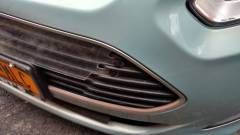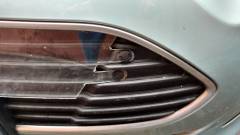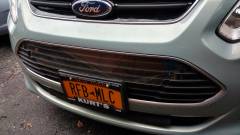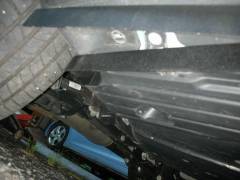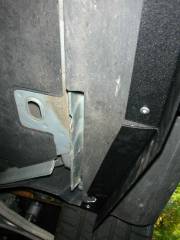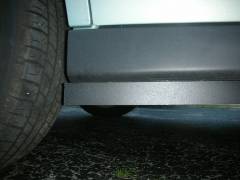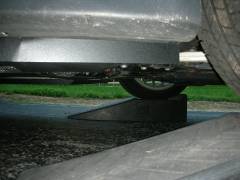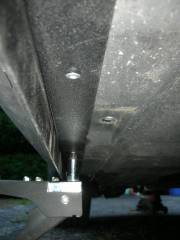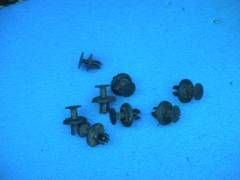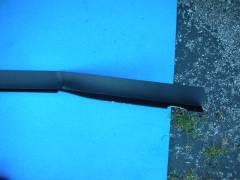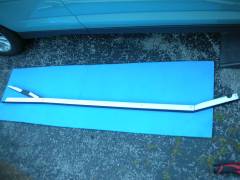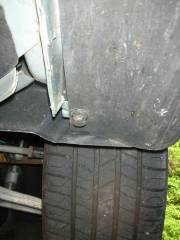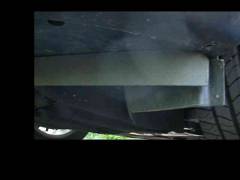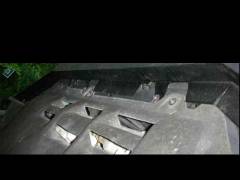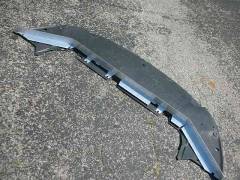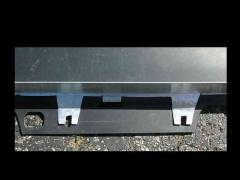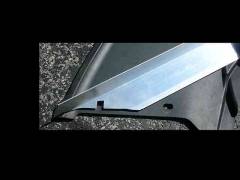-
Posts
1,887 -
Joined
-
Last visited
-
Days Won
178
Content Type
Profiles
Forums
Gallery
Everything posted by fbov
-
From the album: Porter
Grill block detail1 -
From the album: Porter
Grill block detail2 -
From the album: Porter
-
Different batteries. 12V battery needed boosting, as it's the "gatekeeper" for turning on the HVB control system. Standard lead-acid technology. Early models' Achilles heal. High voltage battery (HVB) used for propulsion. This one's the Li-ion battery.
-
Funny, the car in the picture an Escape. No C-Max has the hand hold below the license plate area. Escape and Edge both do. Frank
-
Fins were on cars because fins were on rockets, and since rockets were fast, fins clearly needed to be on anything that moved fast, which meant cars. Pull back from that close-up and you'll see the rocket motor just below the fin on the Caddy. Our '58 Ford Country Sedan had much bigger rockets, but smaller fins. I came across this link, which nicely tells the story of aerodynamic improvements through 1957, at least at Chrysler, culminating in a nice description of the crosswind issue. http://www.allpar.com/history/memories/fins/ And one that's more far reaching in scope. http://www.thetruthaboutcars.com/2010/02/an-illustrated-history-of-automotive-aerodynamics-in-three-parts/ Have fun, Frank
-
Because it's highly unstable in cross-winds. The front of that shape wants to grab the wind, and there's too little drag in the back to counteract it. The nose turns away from the road and won't come back! That's why the Dymaxion has a rear fin, so cross-wind's effect is balanced, front-rear, and the car continues to go where it's pointed. Our cars don't have fins, but take a close look at the windshield integration into the bodywork. The depth of the glass along the A-pillars is for stability, so the air becomes turbulent when it passes over the glass at an angle. Spoil the airflow across the car in a crosswind and you regain inherent stability, without a fin. It's a very common design feature, once you know what to look for. Have fun, Frank
-
Actually, length is very important when comparing vehicle aerodynamics. Height comes in directly as area, while length is in the drag coefficient. (WOW template didn't make it... link is good.) This is the Aerodynamic Streamlining Template from the Ecomodder forum. - The outer dotted outline is the minimum drag shape in free space. For length = 2.5x width "d", Cd is 0.04. - The inner dotted outline is for a half-shape on a flat surface - a car on the road. Minimum Cd is 0.09. That template looks like no production car save the Dymaxion. Our C-Max is a truncated version of this shape. (Template is placed so the wheels are on the ground, and "max roof camber" coincides.) As you can see, the way to reduce C-Max aerodynamic drag is to lengthen the vehicle along the template profile. It's become very popular in trucks. The only reason we play with grill blocks on the front of the car is ease of use; the biggest benefit is always in the wake. Have fun, Frank
-
I'm so sorry to hear your Father-in-law got a stinker. The 12v battery issue would be particularly difficult, as you never know when the car will leave you stranded. I can see how he'd feel snake bit... Our story is the opposite; my 82-year old Father-in-law was the one who bought the car, thankfully an SEL with no particular issues, and he drove it happily until he passed away. There was a certain comfort in knowing his last days were busy and active; the driver's side rear doorway was beat to crap from him shoving his walker in the back seat. How I wish your family has received similar service from your FIL's SE. At least he's still in the market for a car! HAve fun, Frank
-
+1 And you get to listen to the radio while it's updating! OK, that's in the second phase...
-
Let's see... in statistics, a "^" above a variable indicates a predicted value, Y-hat. Plus, "^" kind of looks like a hat. I had a heck of a time finding an image for the plinth that in any way resembled what my mind's eye saw... at least a plinth goes in the right place, underneath. Frank
-
I looked at a simple sampling approach; use a hose just long enough to capture 1oz. Feed the hose into the dipstick port, apply vacuum until full and you're done! The problem is that you need 20+ feet of hose for the thinnest wall tubing that fits the dipstick port. C'est la vie! Frank
-
Perhaps not on level ground... I've done the Rochester NY - Columbus OH run a number of times, and my mileage is always worse in NY. The difference is in terrain; I-90 in NY runs along the coastal plain from ancient Lake Iroquois. The gentle hills aren't steep enough to EV down at highway speeds, but at lower speeds, they make for long EV-powered glides. Ohio from I-90 to Columbus has rolling hills, the legacy of glacial end moraines deposited as ridges across the state. Ohio hills are steep enough to maintain speed in EV mode for long periods, and as we all know, more EV = More MPG. Have fun, Frank
-
Shifting is the wrong paradigm in a hybrid... We want a throttle-foot-accessible "coast" mode, the elusive "no carat" state where the HVB has neither hat nor plinth. Frank
-
I think it's worth a call to Blackstone about the 3M's, that's all. They may be able to tell you something. I agree that a real problem would make itself known... the tranny sure did. I'm less than 4K miles from my next change, so I should have my next data point in April or so, that will answer a number of questions. We'll both have used a Mobil 1 variant. I may send in a T=0 sample from the bottle, just for grins. For sampling, it's hard to beat a hose in the fill tube... a clean hose, of course. HAve fun Frank
-
While I understand the desire to 'soup up" your car, this isn't where you want to do that. Consider a few facts. - Your Energi has 1/3 the HVB capacity of the Focus EV (which truly needs 6.6 KWh) - Batteries charge by application of a voltage greater than the cell's current output voltage, so current flows into the battery. - Li-ion battery life is quickly shortened by overcharging and high temperatures. If you upgraded to the 6.6 KWh charger, one of two things happens If you're in luck, the 6.6 KWh charger never delivers more than the 3.3KWh the Energi's battery can absorb. The batteries never get hot, and never see over-voltage, and last years. If not, your HVB dies really early. Frank
-
For rolling resistance data, I went to Tire Rack, and found 3 tests of passenger car tires that include fuel economy-based comparisons of rolling resistance. http://www.tirerack.com/tires/tests/testDisplay.jsp?ttid=121 http://www.tirerack.com/tires/tests/testDisplay.jsp?ttid=155 http://www.tirerack.com/tires/tests/testDisplay.jsp?ttid=188 The first showed the widest range, as it included a tire specifically not designed for LRR, as well our OEM Michelin Energy Savers. Thus the 7.3% range in fuel economy is much wider than one might expect. The other two tests show a more-reasonable 2% effect. Tire Rack also has a series of article on why you should expect lower MPG whenever fitting new tires in place of worn, based solely on the diameter change, about 2.5%. Switch from OEM to the Goodyear ComforTred, the 7.3% pair, and add in tread depth and you might make 10%! Finally, it depends on your driving mix, as RR is a much larger fraction of highway fuel usage than for city driving. Tire rack gets into this in the first link. You mention using lower tire pressure (which reduces your car's load capacity) when you carry heavy stuff. Clearly a bad idea, but... Not if you use oversize or reinforced or extended load tires. The OEM rating is a 93 load index, or 1433 lb. Use a tire of greater load capacity and it's safe to reduce pressure. - Switching from the P-metric P225/50-17 to a Euro-spec 225/50-17 gets you a 94 load index and 44lb. more capacity per tire. - Switching to an "extended load" 225/50-17 gets you as high as 98 load index, good for 220 lb. more capacity per tire (an available in LRR designs) Food for thought, I hope! HAve fun, Frank PS My Michelin snow tires are XL, yielding a 99 load rating. I see no change in fuel economy when making the switch from summer to winter tires.
-
I threw Paul's data in with mine: - 10K change intervals from 5.8K (I missed the first change), - First two use Ford synthetic blend, the third with a generic full-synthetic 0W20. Mobil One 0W20 is in the sump. Right-most, orange data is Paul's, identified by date and mileage in the legend. Responses are scaled, with the degree of scaling shown in the column ID (e.g. "Zn E-1" means that Zinc values shown are divided by 10). There are some very striking differences. I didn't scale Magnesium; it really is "off the chart!" As to significance, I defer to Bob, the oil guy. http://www.bobistheoilguy.com/engine-oil-analysis/ http://www.bobistheoilguy.com/used-oil-analysis-how-to-decide-what-is-normal/ Many values are comparable, so I'll focus on what's different. That starts with the "3M's" of Molybdenum, Manganese and Magnesium. - Mb is an oil additive, so a 2x difference isn't unreasonable. Mobil may use to a larger degree than Ford or my generic. Next change will tell if it's in the Mobil One lubricant. - Mn is alloyed with other metals, so it's presence should correlate with alloy partners. Metal wear levels are low, so there's no alloy correlate, and the level is 10x higher so it's unlikely an oil additive difference. My next change might be telling but this is odd. - Mg is both an additive and an alloy, and it's 100x greater in Paul's oil. Again, one doesn't expect a 100x difference in an additive level, and there is no obvious alloy partner wearing... Make that very odd! Si levels say you're not getting grit past the air filter; that's good news.Your viscosity is a bit higher, again consistent with severe service interval. I'm glad to see you also have reduced flash point, due to a little fuel in the oil. I'm going to try a little highway driving just before my next change, to see if I can drive the fuel out of the oil. The one place where we see the severe service interval is Barium, as this detergent additive is not found in Paul's oil. How I wish you'd measured TBN!!! My next oil change won't be until Summer, which will address questions of base oil formulation, as we'll both have data from Mobil products. In the mean time, you may want to look in the 3M's, as I doubt those deviations will be explained by oil formulation. I'd start at the source; ask Blackstone if they saw other odd Mg levels when your sample was measured. Have fun, Frank
-

MFT update to v3.8 has been released
fbov replied to raadsel's topic in Audio, MyFord, Navigation & SYNC
Two things. This is a reimaging of the APIM processor. Everything is lost in the process, just like a hitting reset. It's how industry distributes and maintains software, akin to using your PC's recovery partition to recover from a crash. Thankfully, we have very little data on our car radios! (and boy does that phrase sound odd!!) If the dealer balks, remind them that this is covered under warranty. It's straightforward, but if you're not comfortable doing it, you can also pass. I see no benefit. FSA Title: SYNC WITH MYFORD/MYLINCOLN TOUCH - WARRANTY EXTENSION COVERING ACCESSORY PROTOCOL INTERFACE MODULE (APIM) Field Service Action Number: 12M02Frank -
I've deleted posts before posting a couple times already... This car is designed to Pulse and Glide. You just need a sensitive right foot. There is a mode where it actually coasts, neither charging nor discharging. You can't get to it, and if you do, you can't stay there. Instead, I use a zero-bar burn, a discharge carat with no blue bar showing. I can hold it past the point where the blue outline collapses. Very useful for stretching speed approaching a red light, gathering speed going down hills (speed you'll lose EV'ing up the other side of the valley, so why regen?). In fact, I see it as an alternative to regen in cases where the added aero losses might be less than the 10% regen penalty, and the road/traffic allows. HAve fun, Frank
-
And I'll re-post this link, for those interested in battery technology. Each technology is unique, even as they all do the same thing. http://www.batteryuniversity.com/ Frank
-

Strange, long wooooo sound at steady speeds, ICE on
fbov replied to Alex Sams's topic in 2013 Ford C-MAX Hybrid
I've heard this many times, the first time visiting my daughter in Vermont in 2013. The key attribute is the throttle sensitivity; it needs to be in the "Goldilocks" spot, but that's not enough. I also need to be going up the right hill, and that's what makes it so very rare for me. I last heard it a month ago, visiting my daughter for Thanksgiving. In Vermont. Very strange, Frank -
Then you're likely not an engineer.


